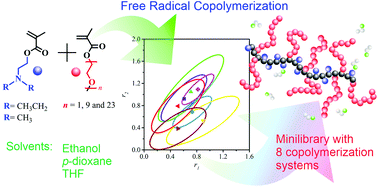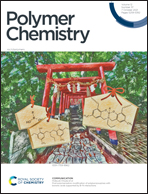The influences of monomer structure and solvent on the radical copolymerization of tertiary amine and PEGylated methacrylates†
Abstract
Tertiary Amine Methacrylates (TAMAs), such as 2-(N,N-diethylamino)ethyl methacrylate (DEAEMA) and 2-(N,N-dimethylamino)ethyl methacrylate (DMAEMA), and PEGylated (macro)monomers, such as 2-ethoxyethyl methacrylate (EEMA1) and poly(ethylene glycol) methyl ether methacrylates with 9 and 23 units (PEGMA9 and PEGMA23, respectively), are two families of monomers frequently used in the synthesis of stimuli-responsive and biocompatible materials. They, along with methyl (MMA) and butyl (BMA) methacrylate, were used to synthesize a minilibrary of copolymers, namely poly(DEAEMA-co-EEMA1), poly(DEAEMA-co-PEGMA23), poly(DMAEMA-co-PEGMA9), poly(DMAEMA-co-PEGMA23), poly(DEAEMA-co-MMA), and poly(BMA-co-PEGMA9). The rate of copolymerization increased as the length of the PEG-side chain is decreased, and was higher for DEAEMA compared to DMAEMA systems. The estimated values of the reactivity ratios are: rDEAEMA = 0.61 ± 0.06 and rEEMA1 = 0.92 ± 0.09, rDEAEMA = 0.71 ± 0.15 and rPEGMA23 = 1.05 ± 0.21, rDMAEMA = 0.83 ± 0.01 and rPEGMA9 = 1.08 ± 0.02, rDMAEMA = 0.52 ± 0.09 and rPEGMA23 = 0.76 ± 0.14, and rBMA = 0.55 ± 0.13 and rPEGMA9 = 0.38 ± 0.09; p-dioxane at 70 °C: rDEAEMA = 0.91 ± 0.12 and rPEGMA9 = 0.75 ± 0.09; and tetrahydrofuran at 66 °C: rDEAEMA = 0.96 ± 0.13 and rPEGMA9 = 0.81 ± 0.11. While there was no difference in relative reactivity between the two amine-functional monomers when copolymerized with PEGylated methacrylates, the increased relative activity of the TAMAs compared to BMA is attributed to the formation of a cyclic intermediate. Additionally, as the PEG side-chain length is extended, the reactivity ratios for the amino monomers decreased. Finally, although a higher content of DEAEMA is incorporated in the copolymer for the poly(DEAEMA-co-MMA) when a more polar solvent is used, no differences were observed in the Mayo–Lewis plots for the poly(DEAEMA-co-PEGMA23) using p-dioxane, tetrahydrofuran and ethanol.



 Please wait while we load your content...
Please wait while we load your content...